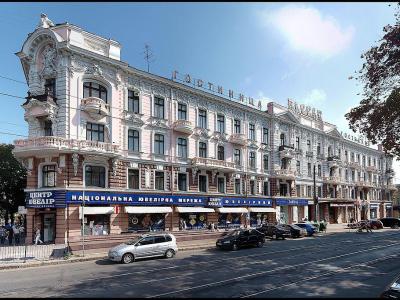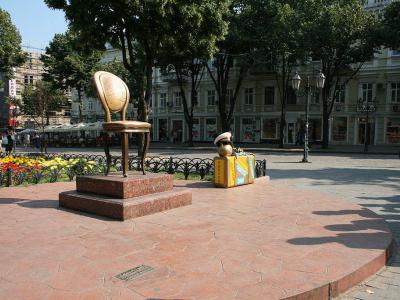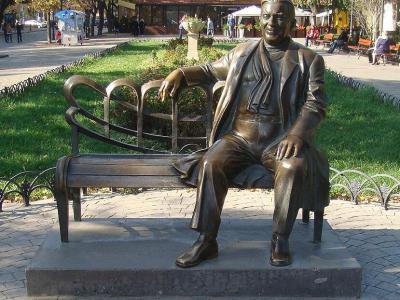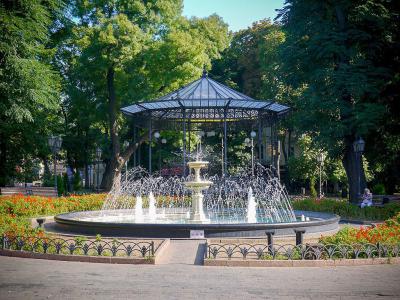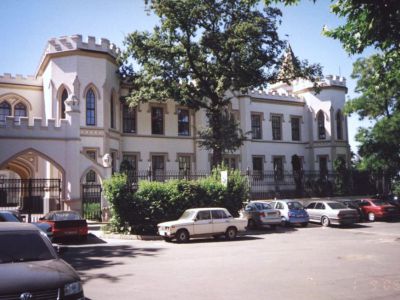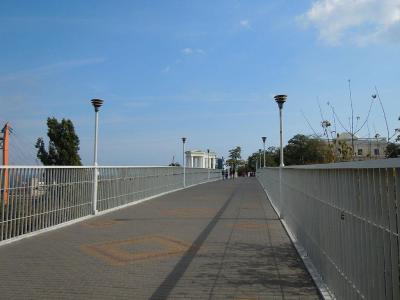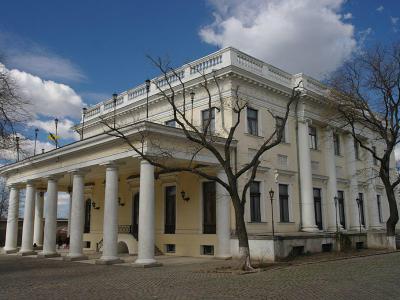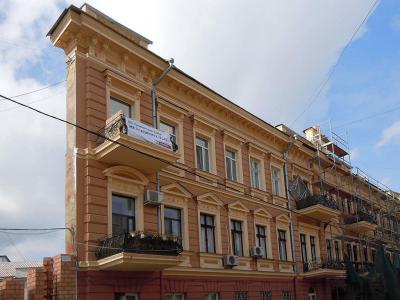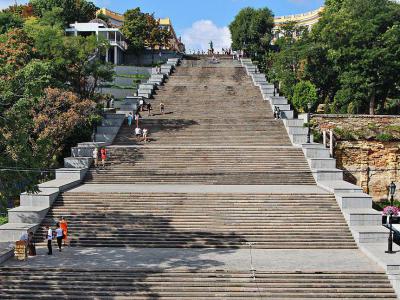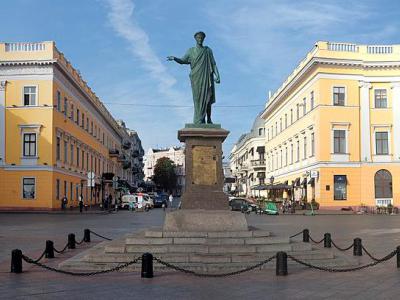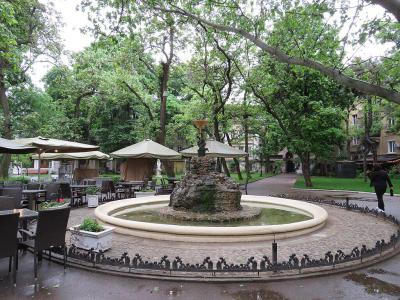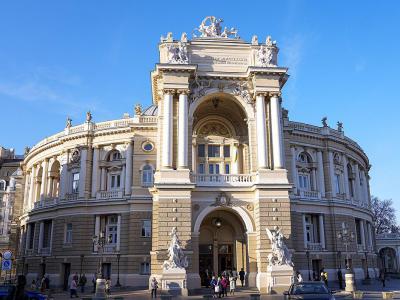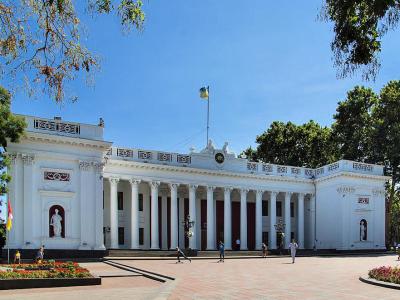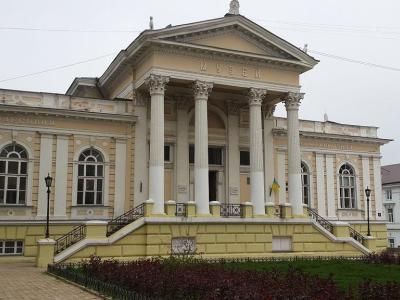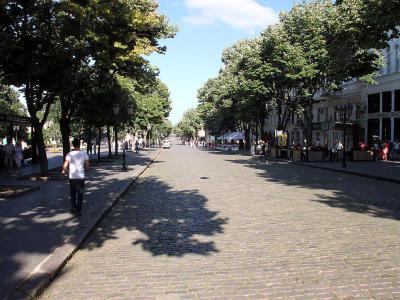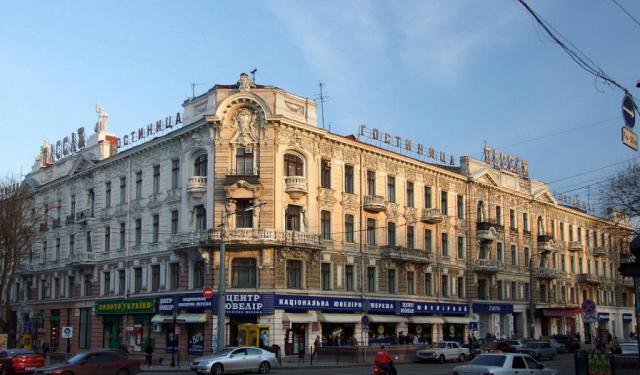Odessa Introduction Walking Tour (Self Guided), Odessa
Odessa is the marvel of a city on the Black Sea shore and a true tourist mecca. Rich in history, it abounds in splendid architecture - buildings, fountains, monuments, statues, and more. Follow this walking tour to explore the most notable sights of Odessa.
How it works: Download the app "GPSmyCity: Walks in 1K+ Cities" from Apple App Store or Google Play Store to your mobile phone or tablet. The app turns your mobile device into a personal tour guide and its built-in GPS navigation functions guide you from one tour stop to next. The app works offline, so no data plan is needed when traveling abroad.
Odessa Introduction Walking Tour Map
Guide Name: Odessa Introduction Walking Tour
Guide Location: Ukraine » Odessa (See other walking tours in Odessa)
Guide Type: Self-guided Walking Tour (Sightseeing)
# of Attractions: 17
Tour Duration: 3 Hour(s)
Travel Distance: 3.6 Km or 2.2 Miles
Author: leticia
Sight(s) Featured in This Guide:
Guide Location: Ukraine » Odessa (See other walking tours in Odessa)
Guide Type: Self-guided Walking Tour (Sightseeing)
# of Attractions: 17
Tour Duration: 3 Hour(s)
Travel Distance: 3.6 Km or 2.2 Miles
Author: leticia
Sight(s) Featured in This Guide:
- Spaso-Preobrazhenskiy Cathedral
- Passage
- The Monument to the 12th Chair
- Leonid Utyosov Monument
- City Garden
- Shah's Palace
- Mother-in-Law Bridge
- Vorontsov's Palace
- Flat House
- Potemkin Stairs
- Duc de Richelieu Monument
- Palais-Royal Garden
- Opera and Ballet Theatre
- Odessa City Hall
- French Cannon
- Odessa Archaeological Museum
- Derybasivska Street
1) Spaso-Preobrazhenskiy Cathedral (must see)
The Spaso-Preobrazhenskiy Cathedral, also known as the Transfiguration Cathedral, is one of Odessa’s most defining religious landmarks. Situated on Soborna Square, it serves as the main church of the Odesa Diocese and has long stood at the heart of the city’s spiritual identity. Its story reaches back to 1794, when construction began on what would become Odessa’s largest Orthodox cathedral. The original building was completed in 1809, marking an early milestone in the young port’s development.
The cathedral’s neoclassical design quickly became one of its distinguishing features. A grand central dome, clean architectural lines, and a bright, harmonious façade made it a prominent element of Odessa’s urban landscape. Inside, visitors encountered a spacious interior adorned with detailed paintings, traditional iconography, and the calm atmosphere typical of major Orthodox churches. Over the years, the cathedral also became the final resting place of notable figures, including Prince Mikhail Semyonovich Vorontsov and his wife, whose remains were reburied here after the modern reconstruction.
That reconstruction was necessary because the original cathedral was demolished in 1936 during the Soviet campaign against religious institutions. For decades, Soborna Square lacked the imposing silhouette that had once dominated it. Only after Ukraine gained independence did the decision emerge to rebuild the structure using historical references. Work began in 1999, and by 2003 the cathedral stood once again, restored to its former architectural presence.
Its resilience was tested again in July 2023, when a Russian missile strike caused severe damage to the building. Restoration efforts began almost immediately and continue today, underscoring the cathedral’s significance not only as a place of worship but also as a symbol of Odessa’s endurance. For visitors, the site offers a compelling blend of history, faith, and architectural beauty—an essential stop in understanding the city’s past and present.
The cathedral’s neoclassical design quickly became one of its distinguishing features. A grand central dome, clean architectural lines, and a bright, harmonious façade made it a prominent element of Odessa’s urban landscape. Inside, visitors encountered a spacious interior adorned with detailed paintings, traditional iconography, and the calm atmosphere typical of major Orthodox churches. Over the years, the cathedral also became the final resting place of notable figures, including Prince Mikhail Semyonovich Vorontsov and his wife, whose remains were reburied here after the modern reconstruction.
That reconstruction was necessary because the original cathedral was demolished in 1936 during the Soviet campaign against religious institutions. For decades, Soborna Square lacked the imposing silhouette that had once dominated it. Only after Ukraine gained independence did the decision emerge to rebuild the structure using historical references. Work began in 1999, and by 2003 the cathedral stood once again, restored to its former architectural presence.
Its resilience was tested again in July 2023, when a Russian missile strike caused severe damage to the building. Restoration efforts began almost immediately and continue today, underscoring the cathedral’s significance not only as a place of worship but also as a symbol of Odessa’s endurance. For visitors, the site offers a compelling blend of history, faith, and architectural beauty—an essential stop in understanding the city’s past and present.
2) Passage (must see)
Odessa Passage is one of the city’s most striking landmarks, often described as a “palace for shoppers.” Located on Deribasovskaya Street, this late 19th-century architectural gem combines the elegance of a luxury arcade with the charm of a grand hotel. Built between 1898 and 1899 by architect Lev Vlodek, the Passage was designed in the Neo-Baroque style, adorned with lavish stucco decorations, sculptures, and a glass roof that floods the interior with natural light. From the moment visitors step inside, they are met with a dazzling display of art and craftsmanship that reflects the optimism and prosperity of Odessa’s golden age.
The building served both as a commercial and residential complex, with boutiques and offices on the lower levels and hotel rooms above. In its early years, the Passage was one of the most prestigious addresses in Odessa, hosting elegant shops, cafés, and salons. The glass-covered atrium remains the focal point, featuring sculptures of mythological figures and allegorical representations of trade, industry, and agriculture—symbols of the city’s thriving port economy.
Today, Odessa Passage continues to function as a mix of shopping arcade and hotel, preserving its fin-de-siècle grandeur while adapting to modern life. Small souvenir shops, fashion boutiques, and restaurants line its walkways, offering visitors a glimpse into the city’s blend of old and new.
A visit to the Passage is more than a shopping trip—it’s a step back into a time when Odessa was among the most sophisticated ports on the Black Sea.
The building served both as a commercial and residential complex, with boutiques and offices on the lower levels and hotel rooms above. In its early years, the Passage was one of the most prestigious addresses in Odessa, hosting elegant shops, cafés, and salons. The glass-covered atrium remains the focal point, featuring sculptures of mythological figures and allegorical representations of trade, industry, and agriculture—symbols of the city’s thriving port economy.
Today, Odessa Passage continues to function as a mix of shopping arcade and hotel, preserving its fin-de-siècle grandeur while adapting to modern life. Small souvenir shops, fashion boutiques, and restaurants line its walkways, offering visitors a glimpse into the city’s blend of old and new.
A visit to the Passage is more than a shopping trip—it’s a step back into a time when Odessa was among the most sophisticated ports on the Black Sea.
3) The Monument to the 12th Chair (must see)
The Monument to the 12th Chair in Odessa pays tribute to one of the city’s most beloved literary icons: The Twelve Chairs, the satirical novel written by Ilya Ilf and Yevgeny Petrov, both Odessa natives. Installed in 1999 in the City Garden on Derybasivska Street, the sculpture captures the spirit of Odessa’s sharp humour and its long-standing affection for the book’s roguish characters. The novel, published in 1928, follows the adventures of Ostap Bender as he hunts for hidden jewels supposedly concealed in one of a dozen chairs—an unlikely treasure quest that has become part of local cultural memory.
The monument depicts the famous Rococo-style chair at the centre of the story, crafted in bronze with an intentionally inviting seat. Visitors often pause to rest on it or pose for photos, continuing the playful tradition that the book inspires. Its placement in the City Garden, a historic park filled with sculptures and live music, adds to the light-hearted atmosphere surrounding the piece.
For Odessa, the monument is more than a tribute to literature; it reflects the city’s identity shaped by satire, wit, and storytelling. The work also acknowledges Ilf and Petrov’s ties to Odessa, anchoring their fictional world within the city's real streets. Today, the 12th Chair remains a popular stop for travellers, blending humour, history, and local pride in one memorable sculpture.
The monument depicts the famous Rococo-style chair at the centre of the story, crafted in bronze with an intentionally inviting seat. Visitors often pause to rest on it or pose for photos, continuing the playful tradition that the book inspires. Its placement in the City Garden, a historic park filled with sculptures and live music, adds to the light-hearted atmosphere surrounding the piece.
For Odessa, the monument is more than a tribute to literature; it reflects the city’s identity shaped by satire, wit, and storytelling. The work also acknowledges Ilf and Petrov’s ties to Odessa, anchoring their fictional world within the city's real streets. Today, the 12th Chair remains a popular stop for travellers, blending humour, history, and local pride in one memorable sculpture.
4) Leonid Utyosov Monument (must see)
In the heart of Odessa, along the pedestrian stretch of Derybasivska Street, stands the Monument to Leonid Utyosov—a bronze sculpture that captures the relaxed spirit of one of the city’s most beloved entertainers. The figure shows the celebrated singer and comic actor seated on a bench, as though taking a pause after a lively performance.
The statue pays tribute to Leonid Osipovich Utyosov, born in 1895 in Odessa, who rose to fame as a jazz‑influenced singer, bandleader, and actor in the Soviet era. He became the first pop‑style performer to receive the title “People’s Artist of the USSR” in 1965. The monument was unveiled in 2000, on the city’s anniversary celebration, offering a friendly cultural highlight for visitors and residents alike.
The location is ideal for a leisurely visit: the bench sculpture sits in the small green space of the city garden adjacent to the famed street, and many visitors like to pause and take a photo next to Utyosov’s likeness. While the monument might appeal especially to those with some familiarity with 20th‑century Soviet popular culture, its charm and accessible setting make it a pleasant stop on a walking tour of Odessa’s downtown.
When strolling through Derybasivska and the surrounding pedestrian zones, allocating a few minutes to this monument adds a personal, human touch to the city’s rich architectural and cultural landscape. Consider visiting during daylight for the best photo lighting, and allow a moment to appreciate how a city remembers its entertainers as part of everyday urban life.
The statue pays tribute to Leonid Osipovich Utyosov, born in 1895 in Odessa, who rose to fame as a jazz‑influenced singer, bandleader, and actor in the Soviet era. He became the first pop‑style performer to receive the title “People’s Artist of the USSR” in 1965. The monument was unveiled in 2000, on the city’s anniversary celebration, offering a friendly cultural highlight for visitors and residents alike.
The location is ideal for a leisurely visit: the bench sculpture sits in the small green space of the city garden adjacent to the famed street, and many visitors like to pause and take a photo next to Utyosov’s likeness. While the monument might appeal especially to those with some familiarity with 20th‑century Soviet popular culture, its charm and accessible setting make it a pleasant stop on a walking tour of Odessa’s downtown.
When strolling through Derybasivska and the surrounding pedestrian zones, allocating a few minutes to this monument adds a personal, human touch to the city’s rich architectural and cultural landscape. Consider visiting during daylight for the best photo lighting, and allow a moment to appreciate how a city remembers its entertainers as part of everyday urban life.
5) City Garden (must see)
The public park known as the City Garden in Odessa lies at the heart of the city’s historic pedestrian street and offers a pleasant retreat from the surrounding urban bustle. It was founded in 1803 by Felix de Ribas, brother of the city’s early administrator, and three years later, he donated the grounds to the city.
Over the centuries, the garden has evolved into one of Odessa’s cherished green spaces, marked by its cast-iron pavilion, an open-air theatre stage used for music performances, and a fountain that operates to timed music in the warmer months. As you stroll through, you’ll find sculptures and monuments – for example, the decorative “Tree of Love” and the quirky monument to the “12th Chair” (a reference to the satirical novel by writers Ilya Ilf and Yevgeny Petrov).
The atmosphere here changes gently as the day progresses. In daylight, the green canopy and winding paths encourage quiet reflection, children’s laughter around the fountain, and the occasional snack café in the nearby façade. At dusk, the lights come on, and intimate concerts may begin on the summer theatre’s stage, lending a slightly theatrical tone to the space.
For someone visiting Odessa, this garden offers both a moment of calm and a slice of local rhythm. It sits on the famous pedestrian avenue, making it easy to incorporate into a casual city walk. As the city’s oldest park, it also provides a tangible connection to Odessa’s urban history – from its early 19th-century design through to its modern role as a meeting place for both residents and visitors.
Over the centuries, the garden has evolved into one of Odessa’s cherished green spaces, marked by its cast-iron pavilion, an open-air theatre stage used for music performances, and a fountain that operates to timed music in the warmer months. As you stroll through, you’ll find sculptures and monuments – for example, the decorative “Tree of Love” and the quirky monument to the “12th Chair” (a reference to the satirical novel by writers Ilya Ilf and Yevgeny Petrov).
The atmosphere here changes gently as the day progresses. In daylight, the green canopy and winding paths encourage quiet reflection, children’s laughter around the fountain, and the occasional snack café in the nearby façade. At dusk, the lights come on, and intimate concerts may begin on the summer theatre’s stage, lending a slightly theatrical tone to the space.
For someone visiting Odessa, this garden offers both a moment of calm and a slice of local rhythm. It sits on the famous pedestrian avenue, making it easy to incorporate into a casual city walk. As the city’s oldest park, it also provides a tangible connection to Odessa’s urban history – from its early 19th-century design through to its modern role as a meeting place for both residents and visitors.
6) Shah's Palace
The Shah’s Palace in Odessa stands out as one of the city’s most distinctive 19th-century residences, known for its striking Neo-Gothic silhouette and unusual ties to Persian royalty. Built in 1851-52 for the Polish nobleman Brzhozovsky, the building initially served as a private mansion before gaining wider attention for its ornate façade, pointed arches, and romantic castle-like proportions. Its design drew inspiration from European Gothic Revival architecture, a style that was rare in Odessa at the time, giving the palace an appearance unlike any other structure in the city.
The building earned its popular name in the early 20th century, when the exiled Persian Shah Mohammad Ali of the Qajar dynasty briefly stayed here after being forced from power in 1909. His presence transformed the mansion into a local landmark with an exotic aura, reinforcing its reputation as a residence connected to international politics and distant courts. Although the Shah’s stay lasted only a few weeks, it left a lasting imprint on how the building was remembered and interpreted by locals.
Throughout the 20th century, the palace underwent several changes in function. It was used by different institutions, including consulates and business offices, yet its original architectural character survived successive adaptations. The façade, with its crenellated roofline and tall, narrow windows, continues to evoke the romantic fascination with medieval Europe that shaped its creation.
Today, the Shah’s Palace remains a notable highlight on Gogol Street. Visitors can admire its exterior and appreciate how Odessa’s architectural landscape absorbed—and reinterpreted—styles from far beyond the Black Sea region. Its layered history, combining local ambition with a brief royal chapter, makes it a memorable stop for those exploring the city’s eclectic built heritage.
The building earned its popular name in the early 20th century, when the exiled Persian Shah Mohammad Ali of the Qajar dynasty briefly stayed here after being forced from power in 1909. His presence transformed the mansion into a local landmark with an exotic aura, reinforcing its reputation as a residence connected to international politics and distant courts. Although the Shah’s stay lasted only a few weeks, it left a lasting imprint on how the building was remembered and interpreted by locals.
Throughout the 20th century, the palace underwent several changes in function. It was used by different institutions, including consulates and business offices, yet its original architectural character survived successive adaptations. The façade, with its crenellated roofline and tall, narrow windows, continues to evoke the romantic fascination with medieval Europe that shaped its creation.
Today, the Shah’s Palace remains a notable highlight on Gogol Street. Visitors can admire its exterior and appreciate how Odessa’s architectural landscape absorbed—and reinterpreted—styles from far beyond the Black Sea region. Its layered history, combining local ambition with a brief royal chapter, makes it a memorable stop for those exploring the city’s eclectic built heritage.
7) Mother-in-Law Bridge (must see)
The Mother-in-Law Bridge is one of Odessa’s most unusual landmarks, known as much for its playful name as for its sweeping views over the city. Completed in 1968, the bridge was designed as a lightweight pedestrian link between Primorsky Boulevard and the landscaped slopes leading to Zhvanetsky Boulevard. Its nickname emerged soon after its construction and has since become part of local folklore. According to one popular version, the bridge was built so a high-ranking Soviet official could quickly reach his mother-in-law’s home on the opposite hillside; another claims the name simply reflects Odessa’s tradition of humour and wordplay.
Structurally, the bridge is a slender steel span elevated high above the landscaped ravine below. Its simple lines and narrow deck were chosen to reduce weight and preserve the surrounding terrain. Over time, its elevated position turned it into a natural viewing platform. From the centre of the walkway, visitors can look toward the harbour, the rooftops of old Odessa, and the tree-filled slopes that edge the historical district.
Beyond its views, the bridge is also a symbol of Odessa’s romantic side. Couples began attaching padlocks to the railings in the early 2000s, turning it into a favoured spot for wedding photographs. Although many locks have since been removed during restorations, the habit continues, and the bridge retains its reputation as a place where people come to mark personal milestones.
Today, the Mother-in-Law Bridge offers a quiet detour for anyone exploring central Odessa. It connects several popular promenades, but its main appeal lies in the combination of gentle humour, urban legend, and the elevated panorama that captures the city’s lively spirit.
Structurally, the bridge is a slender steel span elevated high above the landscaped ravine below. Its simple lines and narrow deck were chosen to reduce weight and preserve the surrounding terrain. Over time, its elevated position turned it into a natural viewing platform. From the centre of the walkway, visitors can look toward the harbour, the rooftops of old Odessa, and the tree-filled slopes that edge the historical district.
Beyond its views, the bridge is also a symbol of Odessa’s romantic side. Couples began attaching padlocks to the railings in the early 2000s, turning it into a favoured spot for wedding photographs. Although many locks have since been removed during restorations, the habit continues, and the bridge retains its reputation as a place where people come to mark personal milestones.
Today, the Mother-in-Law Bridge offers a quiet detour for anyone exploring central Odessa. It connects several popular promenades, but its main appeal lies in the combination of gentle humour, urban legend, and the elevated panorama that captures the city’s lively spirit.
8) Vorontsov's Palace
Vorontsov’s Palace is one of Odessa’s finest architectural landmarks, combining elegance, history, and a commanding view over the Black Sea. Constructed between 1827 and 1830 for Governor-General Mikhail Vorontsov, the palace was designed by the renowned architect Francesco Boffo, also responsible for many of the city’s neoclassical masterpieces. It originally served as the residence of the Vorontsov family, symbolizing Odessa’s prosperity and growing cultural prominence during the early 19th century.
The palace’s design reflects the refined tastes of its era, with a blend of classical and early romantic influences. Its white colonnade, standing at the edge of the Primorsky Boulevard, is among the most photographed sights in Odessa. Known as the Vorontsov Colonnade or the Belvedere, it offers sweeping views of the port and the sea—especially captivating at sunrise or sunset. The structure was conceived as a viewing terrace, harmoniously linking the palace gardens to the city’s waterfront.
During the Crimean War, the palace was partially damaged and later restored, serving different functions over the years, including as a military headquarters and educational institution. Despite these changes, it has preserved much of its aristocratic charm, with graceful facades, arched windows, and ornate details that hint at its grand past.
Today, Vorontsov’s Palace is part of Odessa’s vibrant historical district and a popular stop for visitors exploring the city’s 19th-century architecture. Its peaceful courtyard and panoramic outlook provide an evocative reminder of Odessa’s golden age—a meeting point between empire, art, and the sea.
The palace’s design reflects the refined tastes of its era, with a blend of classical and early romantic influences. Its white colonnade, standing at the edge of the Primorsky Boulevard, is among the most photographed sights in Odessa. Known as the Vorontsov Colonnade or the Belvedere, it offers sweeping views of the port and the sea—especially captivating at sunrise or sunset. The structure was conceived as a viewing terrace, harmoniously linking the palace gardens to the city’s waterfront.
During the Crimean War, the palace was partially damaged and later restored, serving different functions over the years, including as a military headquarters and educational institution. Despite these changes, it has preserved much of its aristocratic charm, with graceful facades, arched windows, and ornate details that hint at its grand past.
Today, Vorontsov’s Palace is part of Odessa’s vibrant historical district and a popular stop for visitors exploring the city’s 19th-century architecture. Its peaceful courtyard and panoramic outlook provide an evocative reminder of Odessa’s golden age—a meeting point between empire, art, and the sea.
9) Flat House (must see)
The building known as the Flat House in Odesa lies in the heart of the city’s historic district and immediately invites curiosity. On a straightforward glance, it appears much like an ordinary 19th‑century residential building, with classical balconies and stucco‑ornamentation quietly echoing the style of the time. But when you shift your vantage a bit, the illusion reveals itself: the house seems to flatten to one simple wall, an effect that both puzzles and delights.
The origin of this architectural trick lies in practical constraints from the building’s past. One version of the story states that the architect ran short of funds during construction and so omitted a back wall, instead bringing two side walls together at an acute angle, creating a triangular plan. Another version suggests the parcel of land was too narrow and the historic street frontage had to be maintained, so the unusual form emerged as a solution. Either way, the result is memorable: from the right position, the house appears to have only a façade.
Built around the end of the 19th century, the Flat House sits at Vorontsovsky Lane in Odesa, close to prominent city sights and thus easy to incorporate into a walking tour of the area. The façade maintains many period details: elegant wrought‑iron balconies, preserved stucco frames, and typical windows of that era. Visitors often pause to take photographs, especially when the light and angle align to enhance the flat‑wall illusion.
Although the visit is brief—this is largely a quick stop rather than a deep attraction—the Flat House rewards attention to perspective, context, and the built environment. It offers a visual twist in a neighbourhood rich with classical architecture, reminding one how constraints of land and budget sometimes prompted inventive design.
The origin of this architectural trick lies in practical constraints from the building’s past. One version of the story states that the architect ran short of funds during construction and so omitted a back wall, instead bringing two side walls together at an acute angle, creating a triangular plan. Another version suggests the parcel of land was too narrow and the historic street frontage had to be maintained, so the unusual form emerged as a solution. Either way, the result is memorable: from the right position, the house appears to have only a façade.
Built around the end of the 19th century, the Flat House sits at Vorontsovsky Lane in Odesa, close to prominent city sights and thus easy to incorporate into a walking tour of the area. The façade maintains many period details: elegant wrought‑iron balconies, preserved stucco frames, and typical windows of that era. Visitors often pause to take photographs, especially when the light and angle align to enhance the flat‑wall illusion.
Although the visit is brief—this is largely a quick stop rather than a deep attraction—the Flat House rewards attention to perspective, context, and the built environment. It offers a visual twist in a neighbourhood rich with classical architecture, reminding one how constraints of land and budget sometimes prompted inventive design.
10) Potemkin Stairs (must see)
The Potemkin Stairs are among Odessa’s most recognizable landmarks, symbolizing the city’s link between the sea and the urban centre above. Completed in 1841, this grand staircase was originally designed by Italian architect Francesco Boffo to connect the port with Primorsky Boulevard. Comprising 192 steps and extending 142 metres in length, the stairs were ingeniously constructed to create an optical illusion: when viewed from the bottom, only the steps are visible, while from the top, only the landings appear—emphasizing the sense of monumental ascent or descent depending on one’s direction.
Originally called the Boulevard Steps, the monument gained worldwide fame in 1925 after its dramatic portrayal in Sergei Eisenstein’s silent film Battleship Potemkin, where a scene of a baby carriage tumbling down the steps became an enduring symbol of revolutionary cinema. This cinematic moment immortalized the site and gave the stairs their modern name, linking Odessa forever with Soviet film history and global culture alike.
Visitors climbing the Potemkin Stairs experience more than a feat of engineering—they walk through layers of Odessa’s history. Bronze plaques mark key points, and midway up, sweeping views of the harbour unfold, framed by classical balustrades and ornamental lamps. The nearby funicular, added in the early 20th century and rebuilt in recent decades, offers an alternative route to the top for those preferring a leisurely ride.
At the summit lies the elegant Primorsky Boulevard, lined with historic buildings, statues, and cafes, while at the base, the bustling port stretches toward the Black Sea. Together, they capture the spirit of Odessa—majestic, cinematic, and always connected to the sea.
Originally called the Boulevard Steps, the monument gained worldwide fame in 1925 after its dramatic portrayal in Sergei Eisenstein’s silent film Battleship Potemkin, where a scene of a baby carriage tumbling down the steps became an enduring symbol of revolutionary cinema. This cinematic moment immortalized the site and gave the stairs their modern name, linking Odessa forever with Soviet film history and global culture alike.
Visitors climbing the Potemkin Stairs experience more than a feat of engineering—they walk through layers of Odessa’s history. Bronze plaques mark key points, and midway up, sweeping views of the harbour unfold, framed by classical balustrades and ornamental lamps. The nearby funicular, added in the early 20th century and rebuilt in recent decades, offers an alternative route to the top for those preferring a leisurely ride.
At the summit lies the elegant Primorsky Boulevard, lined with historic buildings, statues, and cafes, while at the base, the bustling port stretches toward the Black Sea. Together, they capture the spirit of Odessa—majestic, cinematic, and always connected to the sea.
11) Duc de Richelieu Monument (must see)
The Monument to Duc de Richelieu in Odessa marks a landmark moment in the city’s early years. Standing on the upper end of what many know as the Potemkin Stairs, the bronze statue was unveiled in 1828 and is credited as the first monument erected in the city.
The figure depicted is Armand Emmanuel de Vignerot du Plessis, 5th Duke of Richelieu, a French nobleman who arrived in the region in the early 19th century and served as governor of Odesa between 1803 and 1814. His tenure coincided with significant urban and commercial growth: new buildings, port facilities, and a trade‑friendly environment began to shape the city into a regional centre.
The statue itself presents the Duke dressed in Roman‑style drapery rather than contemporary attire, a choice intended to lend classical gravitas to his figure. It was sculpted by Ivan Martos and cast in bronze in Saint Petersburg. At the monument’s base, one can find relief panels and details referencing commerce, justice, and agriculture—elements central to the Duke’s vision for the city.
Visiting the monument offers both a photo‑worthy moment and a chance to reflect on Odessa’s transformation from a modest port settlement into a bustling civic centre in a relatively short period. Many locals still refer to the Duke affectionately as “our Duke”, an indicator of his enduring place in the city’s story. Given its prominent location and historical resonance, it’s worthwhile to pause here and consider the ways in which individuals, design, and commerce converged to shape the city you are walking through.
In passing by the statue, you also gain a sense of the layered history of the city’s development: political exile, imperial service, urban planning, trade expansion, and civic identity all converge in one figure and one setting. That layered story is part of the appeal for visitors keen to understand not just what the city looks like, but how it came to be.
The figure depicted is Armand Emmanuel de Vignerot du Plessis, 5th Duke of Richelieu, a French nobleman who arrived in the region in the early 19th century and served as governor of Odesa between 1803 and 1814. His tenure coincided with significant urban and commercial growth: new buildings, port facilities, and a trade‑friendly environment began to shape the city into a regional centre.
The statue itself presents the Duke dressed in Roman‑style drapery rather than contemporary attire, a choice intended to lend classical gravitas to his figure. It was sculpted by Ivan Martos and cast in bronze in Saint Petersburg. At the monument’s base, one can find relief panels and details referencing commerce, justice, and agriculture—elements central to the Duke’s vision for the city.
Visiting the monument offers both a photo‑worthy moment and a chance to reflect on Odessa’s transformation from a modest port settlement into a bustling civic centre in a relatively short period. Many locals still refer to the Duke affectionately as “our Duke”, an indicator of his enduring place in the city’s story. Given its prominent location and historical resonance, it’s worthwhile to pause here and consider the ways in which individuals, design, and commerce converged to shape the city you are walking through.
In passing by the statue, you also gain a sense of the layered history of the city’s development: political exile, imperial service, urban planning, trade expansion, and civic identity all converge in one figure and one setting. That layered story is part of the appeal for visitors keen to understand not just what the city looks like, but how it came to be.
12) Palais-Royal Garden (must see)
The Palais-Royal Garden in Odessa provides a serene, compact green space in the heart of the city, surrounded by architecture that reflects the area’s 19th-century development. Established as part of the urban expansion that followed Odessa’s early growth as a key port on the Black Sea, the garden formed a pleasant courtyard for the Palais-Royal complex—an ensemble of elegant buildings inspired by European classicism. Over time, the space evolved into a small but valued retreat for residents seeking shade, conversation, and a moment's respite from the city’s busy streets.
The surrounding structures shape the garden's character. Built during Odessa’s flourishing commercial period, they once housed shops, apartments, and cultural venues serving the diverse local population. With clean lines and decorative accents, their façades frame the greenery of the central grounds. The garden is modest in size, yet keeps the feel of an urban courtyard, where architecture and landscaping combine for a balanced, intimate setting.
Visitors will find paved paths, seasonal flowerbeds, and benches arranged to create a quiet corner in the bustling centre. The vegetation ranges from mature trees to low plantings, softening the built environment and offering welcome shade in warmer months. The layout encourages slow movement. It makes the garden a comfortable spot to pause between exploring nearby attractions such as Derybasivska Street and the City Garden.
In recent years, the Palais-Royal Garden has also become a small cultural node, with occasional art displays and local gatherings that bring life to the space without overwhelming its calm tone. The garden’s scale allows visitors to experience Odessa’s historical layers—from 19th-century architecture to modern city rhythms—in a compact setting.
For tourists, the Palais-Royal Garden provides a brief but meaningful glimpse into Odessa’s urban charm. It is a place where historical architecture, public space, and everyday life meet, offering a quiet interlude during a day of sightseeing.
The surrounding structures shape the garden's character. Built during Odessa’s flourishing commercial period, they once housed shops, apartments, and cultural venues serving the diverse local population. With clean lines and decorative accents, their façades frame the greenery of the central grounds. The garden is modest in size, yet keeps the feel of an urban courtyard, where architecture and landscaping combine for a balanced, intimate setting.
Visitors will find paved paths, seasonal flowerbeds, and benches arranged to create a quiet corner in the bustling centre. The vegetation ranges from mature trees to low plantings, softening the built environment and offering welcome shade in warmer months. The layout encourages slow movement. It makes the garden a comfortable spot to pause between exploring nearby attractions such as Derybasivska Street and the City Garden.
In recent years, the Palais-Royal Garden has also become a small cultural node, with occasional art displays and local gatherings that bring life to the space without overwhelming its calm tone. The garden’s scale allows visitors to experience Odessa’s historical layers—from 19th-century architecture to modern city rhythms—in a compact setting.
For tourists, the Palais-Royal Garden provides a brief but meaningful glimpse into Odessa’s urban charm. It is a place where historical architecture, public space, and everyday life meet, offering a quiet interlude during a day of sightseeing.
13) Opera and Ballet Theatre (must see)
The Odessa Opera and Ballet Theatre stands as one of Ukraine’s most iconic landmarks, embodying the city’s artistic spirit and architectural grandeur. First inaugurated in 1810 and later rebuilt after a devastating fire in 1873, the current building opened in 1887 under the design of Viennese architects Ferdinand Fellner and Hermann Helmer. Their creation reflects the late Viennese Baroque style, adorned with opulent stucco work, grand columns, and statues depicting scenes from classical mythology. The theatre’s façade, with its sweeping curves and sculptural detail, remains one of the most photographed sights in Odessa.
Inside, the theatre is no less impressive. The lavish auditorium, with its red and gold décor, crystal chandeliers, and gilded ornamentation, recalls the opulence of 19th-century imperial Europe. Its acoustics are famously precise, allowing even a whisper from the stage to be heard in the uppermost balconies. The ceiling frescoes—depicting scenes from Shakespeare’s “A Midsummer Night’s Dream”—add a poetic touch to the setting, while the horseshoe-shaped hall accommodates over 1,600 spectators in tiers of boxes and galleries.
Beyond its architectural beauty, the theatre has long been a centre of cultural life in Odessa. It hosted premieres and performances by some of the world’s most celebrated artists, including Enrico Caruso, Feodor Chaliapin, and Anna Pavlova. Today, it continues to present a vibrant program of opera and ballet productions, blending classical repertoire with contemporary interpretations.
Evening performances here remain one of the quintessential Odessa experiences—an encounter with history, elegance, and the enduring passion of the city’s artistic soul.
Inside, the theatre is no less impressive. The lavish auditorium, with its red and gold décor, crystal chandeliers, and gilded ornamentation, recalls the opulence of 19th-century imperial Europe. Its acoustics are famously precise, allowing even a whisper from the stage to be heard in the uppermost balconies. The ceiling frescoes—depicting scenes from Shakespeare’s “A Midsummer Night’s Dream”—add a poetic touch to the setting, while the horseshoe-shaped hall accommodates over 1,600 spectators in tiers of boxes and galleries.
Beyond its architectural beauty, the theatre has long been a centre of cultural life in Odessa. It hosted premieres and performances by some of the world’s most celebrated artists, including Enrico Caruso, Feodor Chaliapin, and Anna Pavlova. Today, it continues to present a vibrant program of opera and ballet productions, blending classical repertoire with contemporary interpretations.
Evening performances here remain one of the quintessential Odessa experiences—an encounter with history, elegance, and the enduring passion of the city’s artistic soul.
14) Odessa City Hall
Odessa City Hall is one of the city’s most distinctive landmarks, located on Primorsky Boulevard, just a short distance from the famous Potemkin Stairs. This elegant building serves as the seat of the Odessa City Council and symbolizes the city’s long-standing civic pride. Constructed in the early 19th century, the hall was designed in the Neoclassical style by architect Francesco Boffo, who also worked on several other notable projects in Odessa, including the Potemkin Stairs and Vorontsov Palace. Its bright white façade, grand portico supported by Corinthian columns, and balanced proportions make it one of the most photographed buildings in the city.
Originally completed in 1837, the building stands on the site of Odessa’s first stock exchange, reflecting the city’s origins as a bustling port and commercial centre. The architecture conveys confidence and order, reflecting Odessa’s pivotal role as a vital hub for trade in the Black Sea region. Statues of Ceres, the goddess of agriculture, and Mercury, the god of commerce, adorn the front, symbolizing prosperity and growth.
Visitors approaching the hall are often greeted by the sound of the city clock, which plays fragments of the song “Odessa, My City” each hour. The surrounding square is shaded by trees and framed by monuments, including a statue of Alexander Pushkin, who once lived nearby.
Today, Odessa City Hall is not only an administrative centre but also a cultural and historical landmark. Its well-preserved architecture and setting along Primorsky Boulevard make it a natural stop for anyone exploring the city’s heart.
Originally completed in 1837, the building stands on the site of Odessa’s first stock exchange, reflecting the city’s origins as a bustling port and commercial centre. The architecture conveys confidence and order, reflecting Odessa’s pivotal role as a vital hub for trade in the Black Sea region. Statues of Ceres, the goddess of agriculture, and Mercury, the god of commerce, adorn the front, symbolizing prosperity and growth.
Visitors approaching the hall are often greeted by the sound of the city clock, which plays fragments of the song “Odessa, My City” each hour. The surrounding square is shaded by trees and framed by monuments, including a statue of Alexander Pushkin, who once lived nearby.
Today, Odessa City Hall is not only an administrative centre but also a cultural and historical landmark. Its well-preserved architecture and setting along Primorsky Boulevard make it a natural stop for anyone exploring the city’s heart.
15) French Cannon (must see)
The "French Cannon" in Odessa is a historical monument that commemorates the city’s resilient defense during the Crimean War. Situated in front of the Odessa City Hall on Primorsky Boulevard, this cannon serves as a lasting reminder of the successful repulsion of an Anglo-French naval attack on the city in 1854-1855. Although it is commonly referred to as the "French Cannon" due to its connection to the French squadron involved in the attack, the cannon itself was captured from the British ship HMS Tiger, which was destroyed by Russian defenders during the war.
This remarkable piece of history was recovered from the wreckage of HMS Tiger, a British warship that ran aground and was subsequently obliterated by Russian forces. The cannon, one of the remnants of this dramatic encounter, was eventually placed in its current location as part of the city’s efforts to memorialize the courageous defense against the Anglo-French forces. The monument was unveiled in 1904, marking the 50th anniversary of the defense, and it continues to stand as a symbol of Odessa’s military legacy.
In 2004, the cannon underwent significant restoration work, ensuring its preservation for future generations. The iron parts were repainted, giving the monument a fresh, enduring presence. Visitors today can admire the cannon as it faces the bustling Primorsky Boulevard, one of Odessa’s most iconic streets, where it stands proudly as a tribute to the city's history and its role in the Crimean War.
Despite its misnomer, the French Cannon remains an essential part of Odessa's cultural and historical landscape. It attracts both history buffs and casual visitors, providing a fascinating glimpse into the city’s past while serving as a striking landmark near the Odessa City Hall.
This remarkable piece of history was recovered from the wreckage of HMS Tiger, a British warship that ran aground and was subsequently obliterated by Russian forces. The cannon, one of the remnants of this dramatic encounter, was eventually placed in its current location as part of the city’s efforts to memorialize the courageous defense against the Anglo-French forces. The monument was unveiled in 1904, marking the 50th anniversary of the defense, and it continues to stand as a symbol of Odessa’s military legacy.
In 2004, the cannon underwent significant restoration work, ensuring its preservation for future generations. The iron parts were repainted, giving the monument a fresh, enduring presence. Visitors today can admire the cannon as it faces the bustling Primorsky Boulevard, one of Odessa’s most iconic streets, where it stands proudly as a tribute to the city's history and its role in the Crimean War.
Despite its misnomer, the French Cannon remains an essential part of Odessa's cultural and historical landscape. It attracts both history buffs and casual visitors, providing a fascinating glimpse into the city’s past while serving as a striking landmark near the Odessa City Hall.
16) Odessa Archaeological Museum (must see)
The Odessa Archaeological Museum is one of Ukraine’s oldest and most respected institutions, offering a fascinating look into the region’s ancient past. Founded in 1825, it stands as a cornerstone of Odessa’s cultural identity and a symbol of the city’s long-standing engagement with history and scholarship. Housed in a neoclassical building near the bustling Primorsky Boulevard, the museum holds more than 160,000 artifacts that trace the evolution of civilizations along the northern Black Sea coast. Its elegant façade and colonnaded entrance reflect the 19th-century ambition to make Odessa not only a maritime hub but also a centre of learning and discovery.
Inside, visitors encounter an impressive collection that spans prehistoric times through the Middle Ages. Highlights include archaeological finds from Greek colonies such as Olbia and Tyras, as well as Scythian gold, Roman coins, and Egyptian antiquities. Each gallery offers a glimpse into the lives of those who once traded, farmed, and worshipped in the lands now forming southern Ukraine, revealing the region’s importance as a crossroads of cultures.
The museum’s Egyptian Hall is particularly admired for its authentic mummies, sarcophagi, and hieroglyphic inscriptions—rare treasures that connect Odessa to broader Mediterranean traditions. Another key attraction is the numismatic collection, one of the largest in Eastern Europe, encompassing over 50,000 coins from various epochs and empires.
Beyond its displays, the Odessa Archaeological Museum maintains an active research role, conducting excavations and collaborating with international scholars. For visitors, it offers both a historical journey and an intellectual retreat—a reminder that beneath Odessa’s modern streets lie layers of human history waiting to be explored.
Inside, visitors encounter an impressive collection that spans prehistoric times through the Middle Ages. Highlights include archaeological finds from Greek colonies such as Olbia and Tyras, as well as Scythian gold, Roman coins, and Egyptian antiquities. Each gallery offers a glimpse into the lives of those who once traded, farmed, and worshipped in the lands now forming southern Ukraine, revealing the region’s importance as a crossroads of cultures.
The museum’s Egyptian Hall is particularly admired for its authentic mummies, sarcophagi, and hieroglyphic inscriptions—rare treasures that connect Odessa to broader Mediterranean traditions. Another key attraction is the numismatic collection, one of the largest in Eastern Europe, encompassing over 50,000 coins from various epochs and empires.
Beyond its displays, the Odessa Archaeological Museum maintains an active research role, conducting excavations and collaborating with international scholars. For visitors, it offers both a historical journey and an intellectual retreat—a reminder that beneath Odessa’s modern streets lie layers of human history waiting to be explored.
17) Derybasivska Street
The street known as Derybasivska Street runs through the heart of Odessa and invites visitors into a blend of the city’s past and present. Established at about the same time as the city itself, the thoroughfare was named in 1811 after José de Ribas, the founder of Odessa and its first mayor. It's paved, lined with trees and historic façades, flows straight through one of the city’s most accessible walk‑through zones, free of cars and of moderate size, easily explored on foot.
Architecturally, the street presents buildings in 19th‑century styles, openings to small courtyards, and occasional sculptures that hint at an eclectic mix of influence. Among these is the elegant shopping arcade and hotel complex known as the Odessa Passage, with its baroque/eclectic style and decorative figures. On either side of the street, you’ll find cafés, restaurants, and shops where locals linger and tourists pause—making the pavement more than just a route, but a place to engage.
Flanking part of the street is the city’s first public green space, the Odessa City Garden, created in 1803 by the de Ribas family. The garden provides a pleasant break from urban bustle, with benches and statues, making the area feel rooted in the long arc of local life rather than simply a tourist zone.
As you walk the length of Derybasivska Street, you can sense how Odessa came to be a cosmopolitan port city. Traders, settlers, and architects from many nations shaped the city in the 19th and early 20th centuries, and this street absorbs that layered story through its stonework and street life. At dusk, the street’s cafés fill with light and conversation, offering a front‑row position to observe the city in motion and pause in it for a moment.
In short, Derybasivska Street offers more than a stroll: it offers entry into Odessa’s layered history, architectural character, and everyday scene. For any visitor seeking the pulse of the city, this stretch is a natural place to begin.
Architecturally, the street presents buildings in 19th‑century styles, openings to small courtyards, and occasional sculptures that hint at an eclectic mix of influence. Among these is the elegant shopping arcade and hotel complex known as the Odessa Passage, with its baroque/eclectic style and decorative figures. On either side of the street, you’ll find cafés, restaurants, and shops where locals linger and tourists pause—making the pavement more than just a route, but a place to engage.
Flanking part of the street is the city’s first public green space, the Odessa City Garden, created in 1803 by the de Ribas family. The garden provides a pleasant break from urban bustle, with benches and statues, making the area feel rooted in the long arc of local life rather than simply a tourist zone.
As you walk the length of Derybasivska Street, you can sense how Odessa came to be a cosmopolitan port city. Traders, settlers, and architects from many nations shaped the city in the 19th and early 20th centuries, and this street absorbs that layered story through its stonework and street life. At dusk, the street’s cafés fill with light and conversation, offering a front‑row position to observe the city in motion and pause in it for a moment.
In short, Derybasivska Street offers more than a stroll: it offers entry into Odessa’s layered history, architectural character, and everyday scene. For any visitor seeking the pulse of the city, this stretch is a natural place to begin.
Walking Tours in Odessa, Ukraine
Create Your Own Walk in Odessa
Creating your own self-guided walk in Odessa is easy and fun. Choose the city attractions that you want to see and a walk route map will be created just for you. You can even set your hotel as the start point of the walk.
Downtown Odessa Tour
Downtown Odessa is the heart of this city, where you will find the most prominent attractions and wonderful landmarks. There are numerous monuments of important personalities in the city, beautiful sculptures and gorgeous buildings. Take the next self-guided tour and discover Odessa’s Downtown!
Tour Duration: 1 Hour(s)
Travel Distance: 0.8 Km or 0.5 Miles
Tour Duration: 1 Hour(s)
Travel Distance: 0.8 Km or 0.5 Miles
Odessa Primorsky Bоulevard Walking Tour
Primorsky Boulevard is one of the most prominent streets in Odessa, starting at Dumskaya Square and ending at Vorontsov’s Palace. This popular tourist attraction and wonderful sight is home to several monuments, and is a valuable landmark from an architectural, archaeological and historical points of view. This walking tour will guide you through amazing sights of Odessa.
Tour Duration: 1 Hour(s)
Travel Distance: 0.7 Km or 0.4 Miles
Tour Duration: 1 Hour(s)
Travel Distance: 0.7 Km or 0.4 Miles
The Most Popular Cities
/ view all




